Навигация
6.8. BLACK AFRICAN SCS
Model 50. Initial period of the Black African population existence on the territory of its homeland,
at the stage of clan-tribal organisation (from ancient times until IV century AD)
 | |||
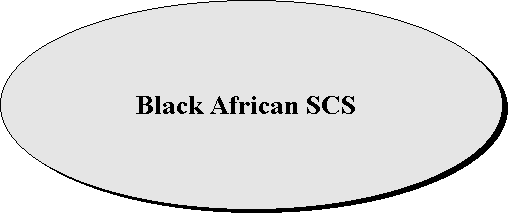 | |||
Model 51. Beginning of the contacts with Muslim SCS, rise of the early states;
creating the Northern and Eastern internal buffer zones (IV - end of the XV centuries)
 |
Model 52. Beginning of the contacts with Western SCS, creating the Western and Southern internal buffer zones. Overseas diffusion of the Black African population and establishing the enclave-communities within alien
socio-cultural formations. Participation in the evolution of South-American SCS, on its 2nd stage
(end of the XV century - 1880-s)
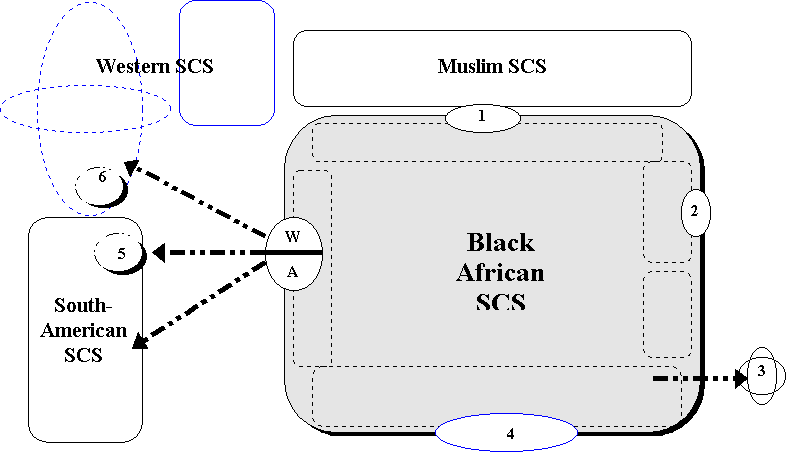 |
Model 53. Spatial seizure of Black African SCS by Western SCS. Introduction of the superficial
economic, social and military innovations. Co-operation of Black African and Russian SCS-s in the struggle
against Western SCS control over the Black African homeland (1880-s - 1960)
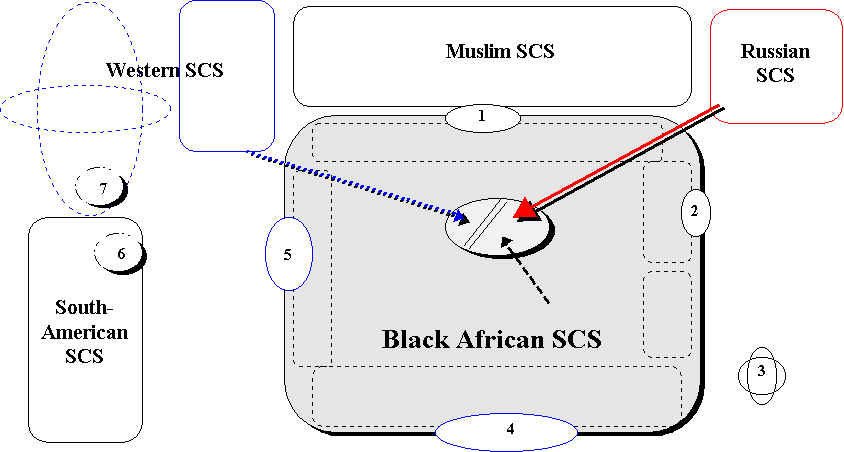 |
Model 54. Liberation of the Black African SCS homeland from military, economic and political presence of
all the alien socio-cultural systems. Operative conversion of the submitted economic and social innovations
(from 1960 and for some future)
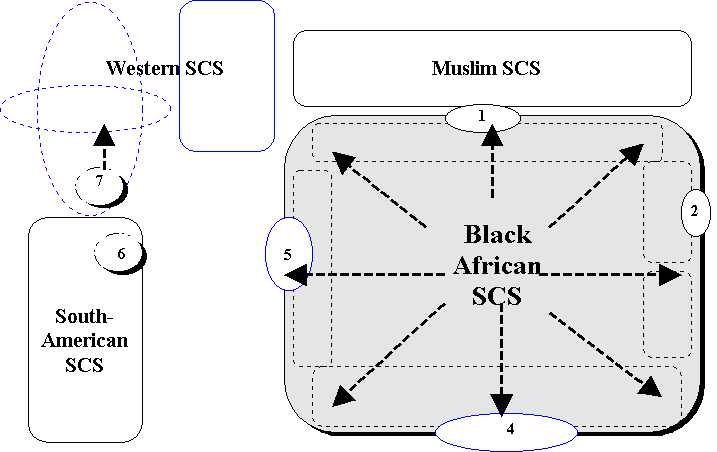 | |||
Model 55. Prognostic stage: Socio-cultural contest in Black African SCS and
its re-structuring in accordance with the own renewed socio-cultural standards
(this period may last for a 100 years or more)
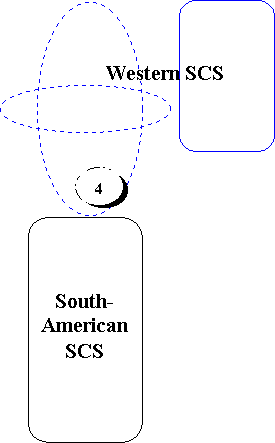 | |||||
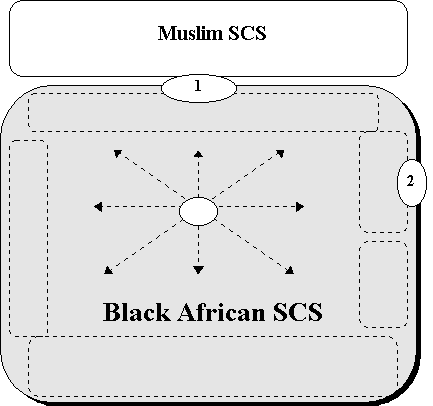 | |||||
Model 56. Prognostic stage: Further intensive development of Black African SCS based on its own socio-cultural standards. Establishing connections between the Black African homeland and its overseas enclave-communities
(quite distant future)
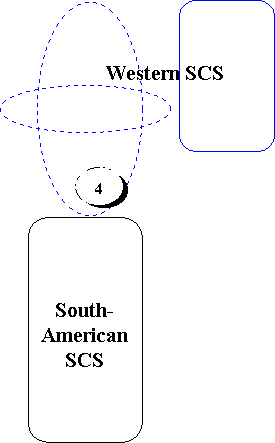 | |||||
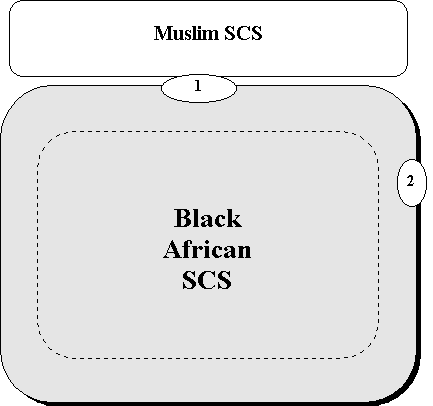 | |||||
7. PERIODS AND SUBPERIODS OF THE SOCIO-CULTURAL SYSTEMS EVOLUTION
| Barbarian-Nomadic SCS | Muslim SCS | Chinese SCS | Western SCS | Russian SCS | Hindu SCS | South-American SCS | Black African SCS |
| From ancient times until beginning of the Christian era | |||||||
| 1.1. - from XXX century until VII century BC | 1.1. - from ancient times until 770 - 750-s BC | ||||||
| 2.1. - from 750-s until 559 BC | 1.1. - from 1800 - 1500-s until 770-s BC | 2.1. - from 770 - 750-s until 500-s BC | |||||
| 2.2. - from 559 until 330 BC | 2.1. - from 770-s until 403 BC | 2.2. - from 500-s until 323 BC | |||||
| 1.1. - from ancient times until I century BC | 3.1. - from 330 until 50 - 40-s BC | 2.2. - from 403 until 221 BC | 2.3. - from 323 until 113 BC | 1.1. - from 2500-s until 320-s BC | |||
| 2.1. - from I century BC until 175 AD | 3.2. - from 50 - 40-s BC until 175 AD | 3.1. - from 221 BC until 25 AD | 2.4. - from 113 BC until 175 AD | 2.1. - from 327 BC until 50 AD | 1.1. - from ancient times until IV century AD | ||
| From the beginning of the Christian era until VI century | |||||||
| 2.2. - from 175 until 375 | |||||||
| 3.1. - from 375 until early V century | 3.3. - from 175 until 380 | 3.2. from 25 until 317 | 2.5. - from 175 until 380-s | 2.2. - from 50 until 320 | |||
| 3.2. - from early V century until middle of the VI century | 3.4. - from 380 until early VII century | 4.1. - from 317 until 580-s | 3.1. - from 380-s until middle of the VI century | 2.3. - from 320 until 711 | 2.1. - from IV century until IX century | ||
| From VI until X centuries | |||||||
| 3.3. - from the middle of the VI century until second half of the VII century | |||||||
| 4.1. - from the second half of the VII century until IX century | 1.1. - from ancient times until 882 | 3.1. - from 711 until 999 | |||||
| 4.2. - from IX century until late XII century | 4.1. - from early VII century until 750 | 4.2. - from 580-s until early X century | 3.2. - from the middle of the VI century until middle - end of the X century | 2.1. - from 882 until 988 | 3.2. - from 999 until early XIII century | 2.2. - from IX century until late XI century | |
| Õ - ÕI - XII - XIII centuries | |||||||
| 4.3. - from early X century until 960-s | 2.2. - from 988 until 1097 | ||||||
| 5.1. - from 1180 until 1205 | 4.2. - from 750-s until late XI century | 4.4. - from 960-s until 1211 | 3.1. - from 1097 until 1169 | ||||
| 5.2. - from 1205 until 1270-s | 4.3. - from late XI century until 1258 | 5.1. - from 1211 until 1280-s | 4.1. - from the middle - end of the X century until 1291 | 3.2. - from 1169 until 1237 | |||
| 5.3. - from 1270-s until 1380-s | 5.1. - from 1258 until 1360 | 5.2. - from 1280-s until 1368 | 4.2. - from 1291 until 1490-s | 3.3. - from 1237 until 1380-s | 4.1. - from early XIII century until 1340-s | 2.3. - from late XI century until 1490-s | |
| ÕIV - XV centuries | |||||||
| 3.4. - from 1380-s until 1478 | |||||||
| 6.1. - from 1380 -s until 1570-s | 5.2. - from 1360 until 1502 | 5.3. - from 1368 until 1644 | 5.1. - from 1490-s until 1660-s | 3.5.1 - from 1478 until 1564 | 4.2. - from 1340-s until 1526 | 1.1. - from ancient times until 1490-s | 3.1. - from 1490-s until 1820-s |
| ÕVI - ÕVII centuries | |||||||
| 3.5.2. - from 1564 until 1572 | |||||||
| 4.1.1.- from 1572 until 1598 | |||||||
| 4.1.2. - from 1598 until 1640-s | |||||||
| 4.2.1. - from 1640-s until late 1680-s | 4.3. - from 1526 until 1658 | 2.1. - from 1490-s until 1650-s | |||||
| 6.2. - from 1570 -s until late 1650-s | 5.3. - from 1502 until early XVIII century | 5.4. - from 1644 until late 1760-s | 5.2. - from 1660-s until 1760-s | 4.2.2. - from late 1680-s until 1700 | 5.1. - from 1658 until 1763 | 2.2. - from 1650-s until 1780-s | |
| ÕVIII century | |||||||
| 5.1.1 - from 1700 until 1756 | |||||||
| 5.1.2. - from 1756 until 1772 | |||||||
| 6.1. - from early until late XVIII century | 5.2.1. - from 1772 until 1795 | ||||||
| 6.3. - from 1660-s until 1800 | 6.2. - from late XVIII until 1880-s | 5.5. - from late 1760-s until 1840 | 5.3. - from 1760-s until 1820-s | 5.2.2. - from 1795 until 1815 | 5.2. - from 1763 until 1818 | 2.3. - from 1780-s until 1820-s | |
| ÕIÕ century | |||||||
| 5.4.1. - from 1820-s until late 1850-s | 5.3. - from 1815 until late 1850-s | ||||||
| 6.4. - from 1801 until 1896 | 5.4.2. - from late 1850-s until 1892 | 5.4.1. - from late 1850-s until 1892 | 5.3. - from 1818 until 1885 | 3.1. - from 1820-s until 1870-s | 3.2 - from 1820-s until 1880-s | ||
| 6.5. - from 1896 until 1953 | 6.3. - from 1880-s until late 1940-s | 6.1. - from 1840 until 1911 | 5.5. - from 1892 until 1918 | 5.4.2. - from 1892 until 1917 | 5.4. - from 1885 until 1945 | 3.2. - from 1870-s until 1918 | 4.1. - from 1880-s until 1940-s |
| ÕÕ century | |||||||
| 6.1.1. - from 1917 until 1924 | |||||||
| 6.1. - from 1918 until 1939 | 6.1.2. - from 1924 until 1939 | ||||||
| 6.2.1. - from 1939 until May 1945 | 6.2.1. - from 1939 until May 1945 | ||||||
| 6.2. - from 1911 until 1949 | 6.2.2. - from May 1945 until late 1980-s | 6.2.2. - from May 1945 until late 1980-s | 4.1. - from 1918 until 1945 | 4.2. - from 1940-s until 1960 | |||
| 6.4. - from late 1940-s until late 1970-s | 6.3. - from 1949 until second half of the 1960-s | 6.2.3. - from late 1980-s until late 1990-s | 6.2.3. - from late 1980-s until late 1990-s | 6.1. - from 1945 until 1974 | 4.2. - from 1945 until 1980-s | 5.1. - from 1960 until late 1980-s | |
| 7.1. - from 1953 and for some future | 7.1. - from late 1970-s and for some future | 7.1. - from the second half of the 1960-s and for some future | 7.1. - from late 1990-s and for some future | 7.1. - from late 1990-s and for some future | 6.2. - from 1974 and for some future | 5.1. - from 1980-s and for some future | 5.2. - from late 1980-s and for sone future |
| ÕÕI century | |||||||
| Subperiod 7.1. continues | Subperiod 7.1. continues | Subperiod 7.1. continues | Subperiod 7.1. continues | Subperiod 7.1. continues | Subperiod 6.2. continues | Subperiod 5.1. continues | Subperiod 5.2. continues |
| total number of subperiods in the SCS-s evolution | |||||||
| 17 | 18 | 18 | 18 | 17 | 15 | 9 | 10 |
GENERAL TABLE OF PERIODS AND SUBPERIODS
IN THE SOCIO-CULTURAL SYSTEMS’ EVOLUTION
| PERIODS AND SUBPERIODS | Barbarian-Nomadic SCS | Muslim SCS | Chinese SCS | Western SCS | Russian SCS | Hindu SCS | South-American SCS | Black African SCS | Average number of subperiods within a period |
| 1 | 1 | 1 | 1 | 1 | 1 | 1 | 1 | 1 | 1 |
| 2 | 2 | 2 | 2 | 5 | 2 | 3 | 3 | 3 | 2.75 |
| 3 | 3 | 4 | 2 | 2 | 5 | 2 | 2 | 2 | 2.75 |
| 4 | 2 | 3 | 4 | 2 | 2 | 3 | 2 | 2 | 2.5 |
| 5 | 3 | 3 | 5 | 5 | 4 | 4 | unknown for the time being | unknown for the time being | 4 |
| 6 | 5 | 4 | 3 | 2 | 2 | unknown for the time being | prognosis | prognosis | 3.2 |
| 7 | unknown for the time being | unknown for the time being | unknown for the time being | unknown for the time being | unknown for the time being | prognosis | prognosis | prognosis | unknown for the time being |
| Number of completed subperiods in the SCS’ evolution | 17 | 18 | 18 | 18 | 17 | 15 | 9 | 10 | Total 122 |
| Number of completed subperiods by the time when 7.1. begins | 17 | 18 | 18 | 18 | 17 | Prognosis 17 - 18 | Prognosis 17 - 18 | Prognosis 17 - 18 | Prognosis 139 - 142 |
Похожие работы
sion. It may border with an external socio-cultural buffer zone as well as an internal buffer zone of a neighbouring SCS. Organisation of an internal buffer zone is characterised by many distinctive qualities determined by the specific evolutionary process of the SCS this particular buffer zone belongs to. EXTERNAL SOCIO-CULTURAL BUFFER ZONE - type of the socio-cultural formations that evolves ...
... и безэквивалентные лексические единицы как ключ к пониманию специфики национальной концептосферы [Текст]/О.М. Смирнова // Вестник Нижегородского университета им. Н.И. Лобачевского, 2008. – №3. – С. 241–245. 21. Соловова, Е.Н. Социокультурные лакуны: типология, причины появления и способы заполнения при изучении иностранных языков [Текст]/ Е.Н. Соловова, Е.А. Кривцова // Иностранные языки в школе ...
... носит разговорный характер. Из эвфонических изобразительных средств в них встречается только аллитерация. Глава 2. ПРОЕКТИРОВАНИЕ СИСТЕМЫ УПРАЖНЕНИЙ ДЛЯ ФОРМИРОВАНИЯ СОЦИОКУЛЬТУРНОЙ КОМПЕТЕНЦИИ НА СТАРШЕЙ СТУПЕНИ ОБУЧЕНИЯ 2.1 Этапы работы с пословицами и поговорками на уроке английского языка Прежде чем приступить к описанию технологии работы с пословицами и поговорками на уроке с целью ...
... для развития творческого потенциала (и, прежде всего, творческого мышления) для подрастающего поколения. Именно поэтому вопрос о проектировании познавательной среды для выпускников общеобразовательных школ в системе дополнительного образования является актуальным. С учетом выше изложенного, при проектировании познавательной среды необходимо учитывать и социокультурный контекст. Именно поэтому ...





0 комментариев